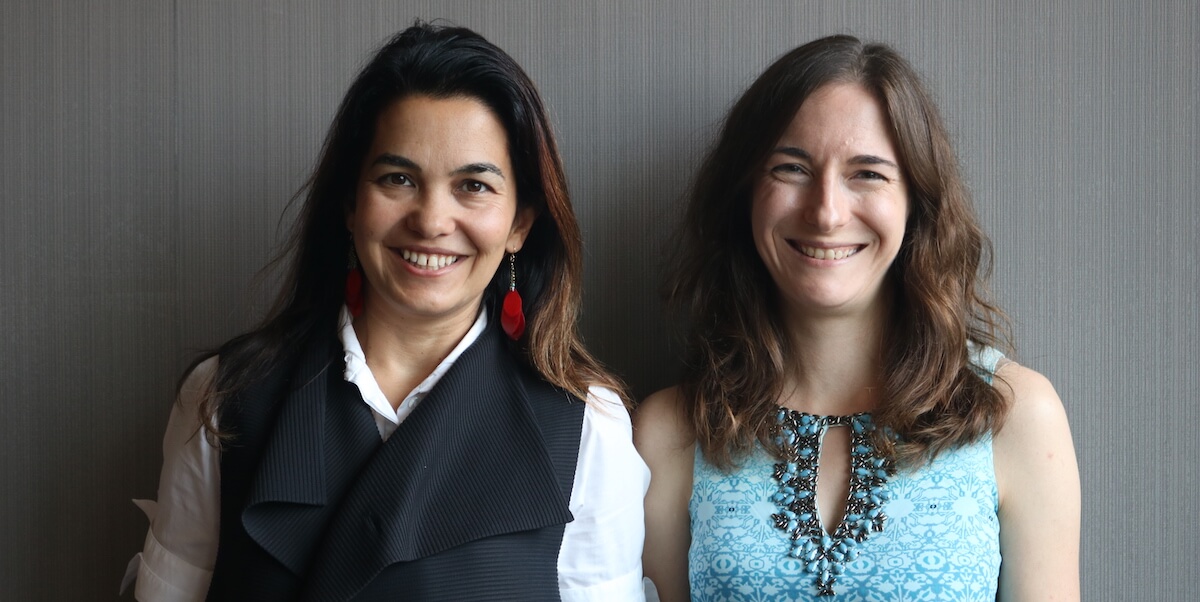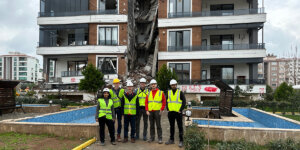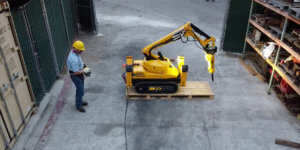
USC Viterbi Professors Burcin Becerik-Gerber and Gale Lucas launch CENTIENTS, a center aimed at fostering research and collaboration toward human-centered design and integration of intelligent technologies into built environments. PHOTO/AVNI SHAH
In the 1960s cartoon The Jetsons, the future was a world full of self-driving cars and sassy, meticulous robots. Individuals, like the patriarch George, could move through space—and the shower—without having to lift a finger. The mechanisms around him played a pivotal role in making decisions on his behalf, based on a learned understanding of his most basic preferences. For a while, this future seemed distant, but upon us now is an unprecedented opportunity to merge human behavior and preferences with automation to create a personalized, dynamic and improved daily reality for individuals at work and at home.
Artificial Intelligence (AI) and advanced technologies for sensing, communication and actuation have been applied successfully to everything from our cars to personal assistants to entertainment. But when it comes to implementing it in our buildings—the places in which we live and work—things become more delicate. Last week, the Center for Intelligent Environments (CENTIENTS) launched to examine the bi-directional interactions between humans and buildings and define an emerging field. The center aims to pave the way forward for smarter, more comfortable and more personalized buildings.
“We are envisioning an unprecedented built environment–one that knows its users, their needs, desires and goals,” said Burçin Becerik-Gerber, co-director and Stephen Schrank Early Career Chair and professor of civil and environmental engineering. “CENTIENTS supports groundbreaking research and brings together scholars, innovators and leaders to tackle some of the most challenging questions brought about by the fast pace of technology implementation, including security and privacy challenges, how intelligent environments should support the future of work and how to build trust in automation. We need to design our future environments to support our goals, rather than dealing with unintended consequences of technology after the fact.”
Helmed by a team of experts and academics from across engineering disciplines at USC Viterbi and across several USC schools, CENTIENTS supports the development of an interdisciplinary community of academics for unique and dynamic collaborations. Expertise spans fields including engineering, computer and data science, social science, design and more. As such, it also contributes to advancements in a number of fields and to a more thorough and responsive understanding of human-centered built environments.
On the significance of the center, Gale Lucas, co-director and research assistant professor of computer science and civil and environmental engineering said: “The world is evolving from the binary extremes of ‘fully manual’ and ‘fully automated.’ CENTIENTS helps to take a step forward to better understand how versions of automation that seek or incorporate human feedback can pave the way for a better life when we are in buildings, which is most of the time.”
Evolution of a New Field
Just as computer science emerged from disparate fields with the recognition that applications of research in math and advancements in mechanical tools like computers could be merged to advance the entire technological landscape, human-building interaction combines other distinct disciplines to foster innovation and progress otherwise unimaginable.
“New fields are born out of people leaving silos and learning to speak another language outside of the jargon of their own expertise,” said Ramesh Balasubramaniam, a professor of cognitive and information sciences at the University of California, Merced and co-organizer of a two-day NSF workshop at USC on human-building interaction. “There are a lot of things that have been learned about human cognition that are useful to builders and designers. An initiative like CENTIENTS adds visibility to the emerging, collaborative research in this area.”
At its outset, there are many critical questions that need to be answered on how to best approach developing human-building interaction as a collaborative and transformative discipline. With the proper groundwork laid, this new field can effectively change the entire landscape for building engineering and design, data collection and even human behavior.
Allen Sayegh, associate professor in practice of architectural technology at Harvard University, agreed. “It’s a very timely initiative. The future trends of built environments will be heavily based on understanding human behaviors and perhaps even drawing lessons learned from human-machine and object interaction. From a designer’s perspective, having engineers, cognitive scientists and social scientists work on these issues is extremely valuable. It grounds the intuitions we as designers have and quantifies them in tangible ways. I feel confident that initiatives like this will pave the way for new policies and guidelines for better human-centered and technologically-mediated environments.”
Unlocking the Power of Human-Building Interaction
An example of the intersectionality of disciplines that CENTIENTS hopes to advance and optimize is embodied in its current projects—all of which are funded by the National Science Foundation.
Smart Desk
A collaboration between USC Viterbi and USC Chan Division of Occupational Science and Occupational Therapy, and a global engineering firm, ARUP, the intelligent office workstation (a smart desk) uses wearable and workstation-mounted sensors to infer human intent, physiological condition and current task. It then uses that information ongoingly to adjust the worker’s local environment (in regard to posture, temperature and lighting). The ultimate goal is not just to make desk workers more comfortable, but to help change the way health and well-being are promoted and achieved in the workplace.
Virtual Reality Based Learning for Construction Worker-Robot Teamwork
As Lucas said, humans are advancing with technology whether we like it or not. In particular, construction workers are being increasingly faced with automation. While automation could potentially help solve many inefficiencies and safety concerns present in this industry, without the proper training and trust in automation, it could prove to cause more problems. Thus CENTIENTS, in a collaboration between USC Viterbi and USC Rossier School of Education, is creating novel training methods delivered through virtual reality to educate workers for new work experiences. The end goal is to improve teamwork among workers and robots on construction sites.
Human-Building Collaboration during Active Shooter Incidents
In many cases, the environments we want to learn the most about are the most difficult to study. While we can put together focus groups to study the impact of a tinted window on comfort, the same cannot be done to help design buildings to facilitate better preparedness for emergencies. CENTIENTS, in a collaboration between USC Viterbi and USC Sol Price School of Policy, is building an immersive virtual environment that will simulate how individuals behave when an active shooter is in the building and how buildings can help their occupants stay safe. As a result of this research, CENTIENTS hopes to enable human-building collaboration by learning more about how different building attributes impact occupant behavior and how these can be better designed to promote occupant safety and improve building security.
“Our goal is to reimagine our future and design for it,” said Becerik-Gerber. “I do not see any reason why buildings cannot be our best allies, helping us learn, stay safe, be healthy and be productive. Ultimately, they could free us from repetitive tasks and improve our daily lives.”
Published on June 14th, 2019
Last updated on September 26th, 2019













